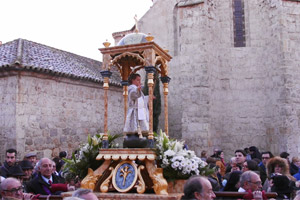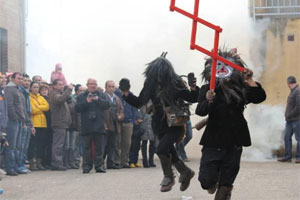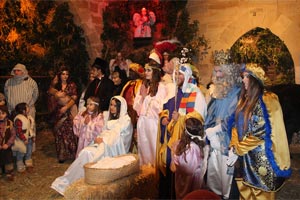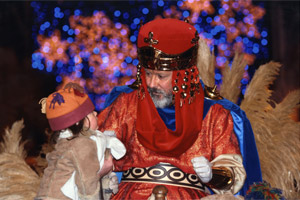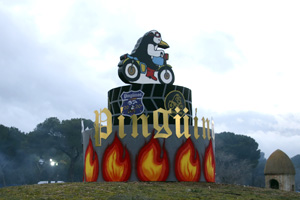Valencia's Maritime Holy Week
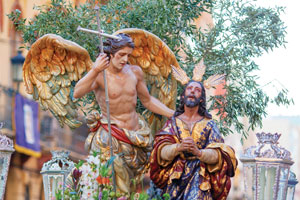
What is Semana Santa Marinera?
The Semana Santa Marinera (Maritime Holy Week) in Valencia is a religious and cultural celebration that takes place in the Grao and Cabanyal neighborhoods of Valencia, Spain, during the week before Easter. The tradition dates back to the 15th century and features a large number of brotherhoods that process through the streets of the neighborhood.
During Semana Santa Marinera, visitors can witness processions of brotherhoods that represent scenes from the Passion of Christ, from the Last Supper to the Crucifixion and Resurrection. The processions are made up of floats that represent Christ and the Virgin Mary, carried on litters by costaleros who parade through the streets of the neighborhood.
In addition to the religious processions, Semana Santa Marinera also features a variety of cultural and festive events such as concerts, children's activities, fairs and markets, sacred art exhibitions, sacred music concerts, theater, children's and gastronomic activities. Highlights include the Grao amusement fair, the Cabanyal fair, and the Maritime Tapas Fair, where visitors can taste typical local dishes such as fideuà, arroz al horno, or paella.
Gastronomy is also an important element of the celebration, with typical dishes such as the Mona de Pascua, a kind of cake decorated with hard-boiled eggs and other elements.
The maritime district of Valencia, known as El Grao and El Cabanyal, boasts a rich maritime tradition and a variety of architectural styles that combine elements from different periods.
Semana Santa Marinera is a unique celebration that attracts a large number of visitors each year. Besides its religious and cultural value, it is an opportunity to discover the history and traditions of these emblematic neighborhoods of Valencia.
Processions of the Semana Santa Marinera
The Semana Santa Marinera of Valencia includes a large number of events, but three processions in particular stand out:
The first of these is the "Visita a los monumentos" (Visitation of the Monuments), which takes place on Holy Thursday. This procession, also known as the drumming, is unique in style, as only drums participate in the bands that accompany the brotherhoods.
The second important event is the "Última Cena" (Last Supper), also celebrated on Holy Thursday, which commemorates the dinner of Jesus with his disciples before the capture. On this day, houses where traditional images are kept are visited, turning them into chapels.
The third event is the most important: the "Santo Entierro" (Holy Burial), celebrated on Good Friday. This is the culmination of the Semana Santa Marinera, where silence and reflection are felt, and where the brotherhoods wear dark clothing as a sign of mourning.
Finally, the "Desfile de Gloria" (Glorious Parade) is the event celebrated on Easter Sunday and is characterized by being very colorful and cheerful. It is a procession of religious images representing the resurrected Christ, the Virgin Mary, and other saints.
The parade starts at the Church of Our Lady of the Rosary and travels through several streets of the maritime neighborhood of Valencia, where processions can be seen on the streets full of people and balconies decorated with flags and Manila shawls.
The main image of the parade is that of the Resurrected Christ, carried in procession by the brotherhoods. By his side is the image of the Virgin Mary, symbolizing the joy of the resurrection.
During the parade, firecrackers and rockets are launched while people applaud and cheer the brotherhoods carrying the images. There is also traditional Valencian music and dance, making the parade a lively and colorful celebration.
What to see in Valencia
Valencia is a city with a great number of tourist attractions, some of which are:
- The City of Arts and Sciences: this impressive architectural complex includes several buildings dedicated to science, art, and culture, among them the Palace of Arts, the Museum of Sciences, the Hemisfèric, and the Oceanogràfic, the largest aquarium in Europe.
- The historic center of Valencia: in the heart of the city, the Carmen neighborhood is the perfect place to stroll through its narrow cobblestone streets, discover its historical monuments such as the Valencia Cathedral and the Basilica of the Virgen de los Desamparados, and enjoy its lively nightlife.
- The Silk Exchange: this impressive 15th-century building is one of the most important examples of Valencian civil Gothic architecture and is located in the historic center of the city. It was declared a World Heritage Site by UNESCO in 1996.
- The beaches of Valencia: along the coast of Valencia, there are several golden sand beaches such as Malvarrosa Beach, Arenas Beach, and Patacona Beach, ideal for enjoying the sun and the sea.
- The Central Market: this modernist-style market is one of the largest and busiest in Europe and is a perfect place to discover local products from Valencia such as horchata, serrano ham, manchego cheese, oranges, and nuts.
- The Turia Gardens: this park, over 9 kilometers long, was created in the former course of the Turia River and is one of the most popular places to walk, exercise, or simply relax in a natural environment.
- The Albufera: this natural park located about 10 kilometers south of Valencia is a paradise for nature and gastronomy lovers. It stands out for its freshwater lake surrounded by rice fields, where the famous Valencian rice is produced, and for its great diversity of birds.
These are just some of the most outstanding places to visit in Valencia, but the city has many other tourist attractions, such as the Ruzafa neighborhood, the Colón Market, the Benimaclet neighborhood, among others.
Recommended Handicrafts and Shopping
Valencia is known for its artisanal tradition and has numerous shops and markets where you can buy typical products from the region. Some of the recommended handicrafts and shopping products are:
- Manises ceramics: Manises is a town near Valencia known for its production of ceramics and tiles. Specialized shops can be found in the center of Valencia offering Manises ceramics products, such as plates, vases, tiles, and other decorative objects.
- Esparto and wicker: Esparto and wicker are two materials widely used in Valencia's handicrafts. Products made of esparto and wicker, such as baskets, hats, and other decorative objects, can be found at the Valencia Crafts Fair as well as in specialized shops in the city center.
- Valencian silk: Valencia has a long tradition in silk production, dating back to the Muslim era. Today, shops can be found offering Valencian silk products such as scarves, ties, and other accessories.
- Horchata: Horchata is a typical Valencian drink made from chufas. Specialized shops in the city center offer handmade horchata and other chufa-derived products.
- Lladró ceramics: The Lladró company, originally from Valencia, is known for its porcelain and ceramics figurines. Specialized shops selling Lladró products can be found in Valencia, as well as visiting its museum and gallery in the city of Tavernes Blanques.
Valencia is an ideal place to acquire typical handicraft products from the region, such as Manises ceramics, horchata, Valencian silk.
Typical Popular Gastronomy
Valencian gastronomy is very rich and varied, with a wide variety of dishes and typical products that have become symbols of the region. Some of the typical dishes and products of popular gastronomy in Valencia are:
- Paella: Paella is one of the best-known and most representative dishes of Valencia. It is made with rice, chicken, rabbit, and vegetables, and is cooked in an iron skillet outdoors.
- Baked rice: El arroz al horno es un plato tradicional de la cocina mediterránea que combina arroz, carne y verduras en un delicioso guiso horneado. Se caracteriza por su textura tierna y jugosa, con un sabor reconfortante y aromático. Los ingredientes principales suelen ser arroz, costillas de cerdo, chorizo, tomate, pimiento, ajo y caldo. También se pueden añadir garbanzos, judías verdes o cualquier otro ingrediente que se desee. El arroz absorbe los sabores de los ingredientes mientras se hornea, creando una mezcla deliciosa y llena de sabor. Es un plato perfecto para compartir en ocasiones especiales o simplemente para disfrutar en familia.
- Fideuá: Fideuá is a traditional dish in Spanish cuisine originating from the Valencian Community. It resembles paella, but instead of rice, short strands of thin pasta, such as fideuá or fine noodles, are used. It is cooked in a paellera with fresh seafood or fish and seasoned with saffron, paprika, tomato, and garlic. Often, ingredients like squid, shrimp, mussels, and aioli are added to enhance the flavor. Fideuá offers a delightful contrast of textures, with crispy noodles on the outside and soft on the inside, all infused with the flavors of the sea. It's a genuine Mediterranean delight highly appreciated for its simplicity and delicacy.
- All i pebre: All i pebre is a stew of eel with potatoes, red pepper, tomato, garlic, and parsley. It is a very popular dish in the Albufera lake area, near Valencia.
- Artichokes from Vega Baja: Vega Baja is a region south of Valencia that is known for its artichokes, considered among the best in the world. They can be found in many restaurants in Valencia during the season.
- Pumpkin fritters: Pumpkin fritters are a typical dessert from Valencia, made with a dough of flour, pumpkin, egg, and sugar, and fried in oil. They are usually eaten during the festival of San Jose, on March 19.
Valencian gastronomy is very varied and rich, with typical dishes such as paella, arroz al horno, fideuá, all i pebre, artichokes from Vega Baja, and pumpkin fritters. These dishes are an essential part of the culture and tradition of Valencia, and can be enjoyed in many restaurants and bars in the city.

